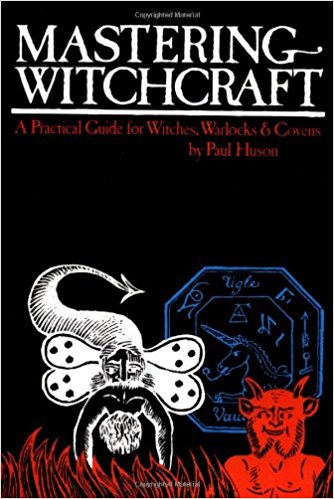You have no items in your shopping cart.
Paul Anthony Huson
Forty years ago Paul Huson wrote the groundbreaking Mastering Witchcraft, and for most of the time the book has remained in print. Paul Huson is a true occult master producing a variety of classic works that have lasted the test of time. Last fall Paul agreed to speak with us about his early occult training and his love of tarot. It is our privilege to bring our readers Paul Huson’s story in his own words.
What was your motivation to write Mastering Witchcraft and how long did it take to put it all together?
My interest in witchcraft in general and magic in particular started at about age ten, when I found that I could scry naturally and apparently cast spells when my intention was sufficiently solid. I guess you could say I started putting Mastering Witchcraft together when I began writing my own book of shadows in 1954, after reading Gerald Gardner’s first book. My main research really took place between 1959 and 1963, when, as an undergraduate of London University, I had the library of the Folklore Society available to me. While I was studying art and design at the Slade School of Fine Art, I used to haunt the folklore library in my off hours – at that time it was housed in the main building of University College.
I emigrated from the U.K. to the States in 1968, hoping to find work in the film industry as an art director, as this had been my career in England. At the time there was supposed to be a reciprocal agreement between the U.S. and U.K. film and TV unions, but on arriving in Los Angeles I had found this not to be the case. It was one of those closed shop deals – you had to have done some design work in the States to get accepted into the union, but you couldn’t actually get a job unless you were already in the union. In any case, art directing was not really my idea of a wonderful career, so at the time I never even gave a thought to the idea of using a spell to attract work. Friends suggested I write a book. “Witchcraft” seemed to be in the air at the time, so I wrote a couple of chapters and an outline based on my research. A friend gave it to an agent at William Morris, who thought it reasonable enough to pass on to the literary department in New York, and it was sold in short order to Putnams. The actual text and illustrations took me about three months to complete, I believe.
What contact, if any, did you have with practitioners of witchcraft or magic before writing Mastering Witchcraft?
After reading Gardner’s books when they came out in 1954, I had written to him when I was fifteen, asking if he knew of a group where I could study magic formally, giving him details of magical experiments I had carried out. Interested, he wrote back, invited me to meet him “for a yarn,” and mentioned the Society of the Inner Light as the best place to get a training in magic, although he doubted they’d take anyone my age. Any more occult adventuring on my part, however, was abruptly curtailed at this point by the discovery of school séances I had been organizing. The headmaster took a dim view of them, believing them to be diabolical in inspiration, which they were not, and threatened me, as the instigator, with immediate expulsion should he so much as even catch me reading an occult book in the future. So my wings were clipped for the time being.
However as soon as I left boarding school to attend the Slade in 1959, I applied to the SIL, Society of the Inner Light, for membership. Contrary to Gardner’s expectations, I was accepted as a candidate for their mail order training course. At this time it involved reading the society material, and once a fortnight answering questions on it, performing daily meditations on various set subjects and submitting your meditation log and replies to the question sheet to a mentor at the society for inspection. All this was designed to not only teach the student, but to draw him or her into the group’s egregore and aid him or her in picking up the contacts the SIL worked at that time. I discovered that someone named Arthur Chichester was to be my mentor, although I had no idea at the time that he was the Society’s warden. I completed the first part of the course, apparently to his satisfaction.
However I began finding the material inconsistent and in some places self-contradictory, notably the Qabalistic material, which I had been fairly well versed in before I applied for membership, which clashed with the more theosophical type of “cosmic doctrine” material propagated by the Society. I voiced my problems to Chichester and he made light of them, suggesting I was just reacting to the “form” of the teaching, but that basically everything was consistent. However I could not rid myself of my skepticism, this has been a recurring issue all my life, I find and rightly surmised that I couldn’t continue working with the group while in that frame of mind. So that was the end of the SIL for me; materially, at least. However I’m fairly sure I’d picked up some of their contacts.
Could you elaborate on what sort of contacts you reference? Are these spirit guides, godforms?
Godforms. The SIL taught that the form of the shaggy-hooved Great God Pan was a powerful symbol of “the divine as manifested through nature.” As a painter and designer, I was drawn to what the society called the Orphic or “Green Ray” path, which used the symbolism of European myth and folklore – Etruscan, Celtic, Nordic, which for me meant Aradia, Cernunnos, Odin, Freya, Weyland, and later forms like the fairy folk and Holda, Habondia, and Hertha – to make inner-plane contacts.
Were there specific sources that you can identify as being the main influences on the tone and style of the book?
Barham’s Ingoldsby Legends and Jack Vance’s writings, I should think. I felt that a book about witchcraft should not only be informative, but stimulate the imagination of the reader, cast its own spell, so to speak. Books on occult subjects until then always seemed to me to tend toward the turgid, which is something I was anxious to avoid.
How much of your work for Mastering Witchcraft was pure research, and how much was revealed as a result of meditation or praxis?
The “witch power” produced from what I called the Witches’ Pyramid, i.e., the force that aids the operator to achieve the necessary inner plane or Deep Mind contact to work magic, was a working concept I evolved from following clues given by Albertus Magnus, Agrippa, Paracelsus, Levi, Crowley, and yes, even Gardner himself. It forms the basis for the success of any of the rituals. As to the rituals’ origins, I would answer half research, half the result of my own “ingenium,” as Crowley would say. For instance, the elemental invocations were developed as a result of my own intuition and praxis, and the tool consecrations were pretty much Key of Solomon and Golden Dawn. So to answer your question, I would have to say Mastering Witchcraft was half pure research and half a result of meditation and praxis.
In Mastering Witchcraft you mention watcher lore, Tubal Cain as the Witch God, Nahmaah and Lillith which are more commonly associated with traditional craft than with Gardner’s Wica and the more eclectic forms of witchcraft prevalent today. Did your encounters with associates of Robert Cochrane, who is best known as a proponent of traditional witchcraft, expose you to these concepts or had you encountered them via other venues?
The lore to which you refer I acquired as a result of my own personal research and meditation. During my meetings with folk like Bill Gray, I was only presented with interesting minutiae, like the correct method to visualize the Interior Castle or how to use the image of the blue periwinkle as the flower of death – none of the basic materials or godforms. I was surprised, not to say intrigued, when a certain Joe Wilson wrote to me after he had read Mastering Witchcraft and informed me how much it apparently contained of Cochrane’s teachings. I can only assume that I had picked up the Cochrane folk’s egregore/group mind while I was in their company.
There have been rumors of association with Alex Sanders and other Wiccans. I know you have previously answered this particular question in an online forum, but that posting is long gone and I believe this venue provides an opportunity to get your answer out to a wider audience. The question of your “origins” comes up over and over. I’d like to have your position on the issue to stand as a definitive answer.
I was not the “Paul” mentioned in June Johns’s account of Sanders’s life, nor did I ever have the pleasure of meeting Sanders, or to my knowledge any of his folk, although maybe they were present at some of Tamara’s salons. For the record, I have never been initiated into any coven, and I have certainly never broken any secrecy oaths.
In the years since the publication of Mastering Witchcraft, witchcraft has undergone a modern renaissance and there are now hundreds of books on the subject and many differing groups practicing a variety of forms both traditional and modern. Do you have any regular contact with practicing witches or traditions?
I keep in fairly regular contact with Nigel Jackson, and used to have sporadic contact with Joe Wilson until he died.
How do you see your role in promoting the resurgence of interest in witchcraft over the last forty years?
I guess I was the first writer to present the general public with a practical guide to witchcraft rituals at a time when it was almost impossible to gain that kind of information unless you were initiated into a coven or lodge. I gather Mastering Witchcraft remained an influential book over the years, despite opposition from fundamentalist Christians and Gardnerian Wiccans of the “Wiccan Rede” persuasion. I didn’t pull any punches in the book, and folk like Farrar took pains to label it amoral, if not immoral. Wiccan Reders also latched onto my use of the word “warlock” as somehow significant; warlock of course is a perfectly standard Scottish term for a male witch and has nothing to do with oath-breaking or coven excommunication or any of that kind of folderol you find bandied about on the Net.
Have you considered writing a sequel or an updated version of Mastering Witchcraft?
No. As for a sequel, I think the field is somewhat oversaturated, and my interests have moved on since then.
You have also authored two books on the subject of the tarot, The Devil’s Picture Book and Mystical Origins of the Tarot. I also understand that a tarot deck Dame Fortune’s Wheel Tarot is in production. In your view how does the tarot fit into the world view and practice of the witch?
Although probably initially devised as a card game, from the sixteenth century, at least, I believe the tarot has been used in Europe as an instrument of divination. As such, it’s a perfectly viable magical tool for those who work within what Dion Fortune used to call “the Western esoteric tradition.” The trumps and court cards reflect a medieval Catholic Christian world view, but it is a Christianity that has clothed its simple gospel tale in a garment of classical paganism and Neo-Platonism, and as such presents images resonant to Christian and pagan alike.
Haunting good libraries is a fine way to satisfy the yearning for learning no matter what the subject matter may be. For such adventurous seekers or even the more experienced readers among the stacks, what advice would you give about structuring a self-directed curriculum to help aid the greater journey on the esoteric path?
People have their own inner needs which only they can identify. Obviously these needs are what should direct their book research. Without knowing the person, it’s impossible to give advice to someone, especially on esoteric matters. There are so many different paths, so much literature available today.
Could you explain for our readers what an egregore is, and what value it may have provided to you as a student of the mysteries?
Actually, “egregore” wasn’t a term used at that time by the Society of Inner Light. Once, when I babbled it in passing, having encountered it in the writings of W.E. Butler, whom I knew to have been associated with the Society, Chichester claimed to be unfamiliar with it. “Group mind” was the term they used then. Basically this refers to the telepathically induced entity of shared ideas developed by a closely knit group of like-minded people, such as a lodge, coven or chap- ter. It may, should, act as an assist for any new member, keying him or her into the inner-plane contacts of the group by a process akin to electromagnetic induction – provided he or she is like-minded.
Did you ever meet Gardner?
I’m afraid I never got around to meeting him, so my first solid encounter with Wiccans wasn’t until several years later, when I replied to an ad in Prediction magazine addressed to prospective witches. At a flat in Baker Street I met a young male witch named Neville Lab- worth and his lady, who were intent on forming a new coven, and to that end they lent me a copy of Charles Cardell’s book to introduce me to their rituals. I noted that material had been apparently adapted by Gardner or someone from Aradia, Carmichael’s Carmina Gadelica and Crowley’s works – all of which I had discovered years before in the folklore society library. So rather than join the Wiccan coven, I decided to join a Hermetic group that had been formed with the apparent blessing of Israel Regardie to study Golden Dawn material and Enochian magic.
In the early 1960s witchcraft/magic was often an either/or matter, and I opted for magic. I think Labworth would have been perfectly happy for me to belong to both groups, but Tamara Bourkoun, the lady who headed the Order of the Pyramid and the Sphinx, the Hermetic group I eventually decided to study with, was of another mind altogether, and rather looked down her nose at Gardnerians. Interestingly it was while I was studying with Tamara that I received my second introduction to quite a different type of witchcraft via Cochrane witches, who would attend the salons that Tamara periodically gave, although Cochrane himself was never there, so I never met him.
Can you share with our readers any anecdotes of your own use of tarot for either divination or magical practice?
I’m afraid not. As for tarot divination, I rarely divine for myself, and when I read tarot for others I consider the information obtained to be private and privileged, rather like a material from a psychotherapy session. On the other hand, scrying tarot images or invoking the powers in them is of course a perfectly legitimate magical practice, but one that I haven’t undertaken in a very long time. In any case, I have not made use of any Qabalistic tarot formulations in decades, as I believe the connection between tarot and Qabalah to be conventional and artificial rather than historically or even intuitively accurate, so the results I obtain are usually quite different from the usual Golden Dawn related pathworking scenarios.
I’ve also come to believe that for whatever reason, the Major Arcana is currently undervalued and treated on a par with the minors. This I think is a great mistake, not just for historical or literary reasons, but practical as well. In my experience the majors are symbols to be used with caution and respect. You open yourself up to powerful forces if you play around with them carelessly. The Wheel, Hanged Man, Death, Devil and the Tower are not images to be invoked idly, and even if you invoke one of the less harmful-looking trumps, you can often find yourself contacting others too, like it or not, for the majors are a sequential unit.
I sensed something strange and magical about regular playing cards when I was a toddler. When I discovered the tarot deck, I was of course hooked. I completed making my first deck of majors, copying the Rider-Waite-Smith designs from Madeline Montalban’s articles in Prediction, on file cards when I was in my teens, my second full deck when I was twenty, a third when I was twenty-six, a fourth set of majors when I was thirty, and finally a fifth complete deck in 2006. I have named it Dame Fortune’s Wheel Tarot, and it is based on the researches of my latest book Mystical Origins of the Tarot. Lo Scarabeo is planning to publish this deck in 2009.







